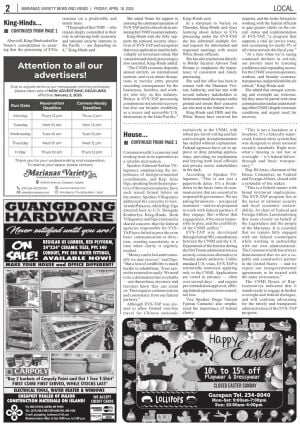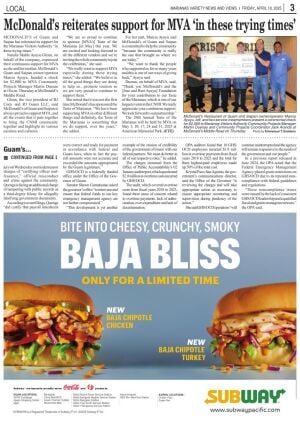
An ad for a store, as published by Marianas Variety in 1983.
IN 1983, the South Pacific Commission or SPC (now known as the Pacific Community) issued a “country report” regarding the Northern Marianas. It is — like other old reports about these islands — a fascinating read.
According to the SPC report, the economy of the then-five-year-old U.S. Commonwealth “revolves around government employment highlighted by…a bicameral legislature for a population of 17,000.” The “seeds of this administrative orientation may have been sown in the period of reconstruction immediately at the end of the war,” the report stated. That was when “a local economy…developed that depended essentially on government employment,” the report added, citing the findings of the American anthropologist Alexander Spoehr in his 1958 book, “Saipan: The Ethnology of a War Devastated Island.” In 1977, “of the 7,007 people working in the Marianas, l,411 were employed by the [U.S. administered-Trust Territory] government, 1,716 by the district legislature and 200 with government agencies. General merchandising employed 773, hotels and other catering services 733, construction companies 714 and transportation and stevedoring 323.”
William Stewart was an American economist who worked for the TT administration, and later, for the CNMI government. In an interview in 1993, he recounted what working for the TT government entailed: “What it did provide was a payroll…. We will hire them and they’ll sit at a desk, won’t be very much to do, but we just can’t have them going out sitting under a coconut tree somewhere. They’re going to have to sit there eight hours a day and do the typing or push the paper or whatever it was that had to be done in order to justify this pay.”
Not surprisingly, government jobs were “highly coveted.” This “attitude” has had “a massive influence not only on the direction of the island economy but also on the composition of the labour force,” the SPC report stated.
It noted that in 1937, during the Japanese administration of the islands, the total agriculture area was 36,900 acres. By 1980, this had dwindled to just 600 acres, and fruit and vegetable production had dropped to approximately 5% of what it was before the war.
“Almost all food is imported, hence expenditure on food represents over 40% of all consumer expenditure…and food and drink imports represented 55% of the value of all imports…., the highest figure recorded in the Pacific region. Indicative of this dependence is the existence of a Nutrition Assistance Program…, begun in mid-1982, which at that time had 819 participating households (some 4,6l6 persons, around 28% of Marianas citizens). In October 1982 there were…4,395 participants, of whom 3,628 were on Saipan, and cases of condensed milk and cheese were being distributed freely, much to recipients lined up in large cars….”
Even the more remote Northern Islands were “far removed from self-sufficiency. Despite having a supply ship only every three months, at the end of 198l it was observed that the people of Agrihan produced only coconuts, papayas and mangoes and were otherwise dependent on U.S. Department of Agriculture…supplies…. Agricultural potential is underutilised yet it remains to be demonstrated whether the potential for C.N.M.I. agricultural production can be realised given the Commonwealth’s present labour force and general economic and social conditions.”
The SPC report said “limited soil potential, the necessity for irrigation in some areas and a climate in which tropical cyclones are not unusual are natural hazards to agriculture, which has become an essentially secondary or casual economic activity. There is nevertheless considerable potential for joint venture farming, although it is probable that much of the labour would have to be imported.”
The SPC report also noted that the islands’ electricity consumers “are…heavily subsidized and the potential for savings on energy costs is substantial although the task will be difficult since positive attitudes towards energy conservation and against conspicuous consumption are virtually absent.”
You don’t say.
In the early years of the Commonwealth, a full-blown tourism industry was still a dream, and the island economy was heavily dependent on federal funds. “In 1979, domestically generated revenue was valued at $7.5 million and U.S. grants and expenditure of different kinds at $20.3 million. This level of dependence at relatively high income levels has consequently resulted in the Marianas people sometimes being referred to as ‘wealthy beggars’…[and] one of the principal issues in the 1981 elections was over the extent to which the Marianas had become nothing more than a welfare state and how this dependence might be reduced….” An “Overall Economic Development Strategy (1981) actually comments on the need for greater economic self-sufficiency [but] there is a much more general concern that, in some respects, U.S. assistance has not been at the anticipated high levels.”
How is that any different from what we usually hear today from certain CNMI officials?
According to the SPC report, “Without…foreign investment the achievement of the [living] standards aimed at in the Marianas would be impossible from domestic resources alone.”
Incidentally, in the early 1980s, “there were over 5,000 vehicles” on Saipan, “but no public transportation system, although a bus system existed for five weeks of 1982, and previously in 1980.”
In those days, there was “a general assumption that Tinian will become an important military base for the United States….”
As for public health, the “principal causes of death in the late 1970s were heart diseases and malignant neoplasms (cancer), diseases essentially similar to those in developed countries (such as the United States) rather than other parts of the South Pacific region.”
Almost all the population on Saipan lived “on a strip of land along the west coast, … the ‘urban area’ principally between Garapan and Chalan Kanoa.” The largest migrant group were the Filipinos: “they were already significant in the 1960s working principally for construction companies or in the government bureaucracy but their numbers grew rapidly in the 1970s.” Nearly “80% of the positions for skilled labourers, technicians, foremen and other professionals in the construction industry are held by aliens,” the SPC report added.
One CNMI lawmaker was quoted as saying that the islands “required fewer political scientists, mayors and lawyers and more plumbers, carpenters and electricians.”
According to the report, achieving socio-economic development and a U.S.-level standard of living requires more labor and a broader range of skills than the Commonwealth’s small population can fully supply. “No community of comparable size in the U.S. (or elsewhere) would even try to attain this standard of living relying on its internally generated labor force…. It may be that the Northern Marianas is destined to become a [jurisdiction] with a dual structure of government officials from the Northern Marianas and alien workers in most other sectors (much like that of the American Virgin Islands).”
Send feedback to editor@mvariety.com

















